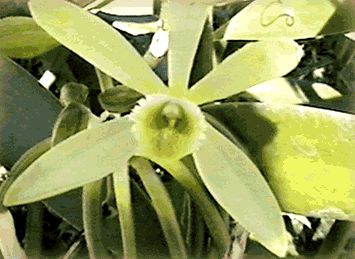Réunion flora.

Réunion Island is rich with many floral species. Gladiolus, dahlia, nasturtium (which is used to make fritters), digitalis... are very common alll over the Island.
In the summertime; "les flamboyants" (flaming trees: very beauiful red flower trees that blossom for Christmas), bougainvilleas, mimosa are flowering. They are replaced by daisies, margeurites and fuschias in the wintertime.
This so fertile island can offer you a large choice of delicious tropical fruits: guavas, mangoes, lychees, pineapples... . They all appear at a different time of the year so that you can eat tropical fruits all year long. Vanilla, manioc, and sugar cane are also very present.
The isalnd tops are covered with tropical forest (tamarinds,..)
Vanilla.

Vanilla is an orchid, the flavour of which is known and used for a long time. As early as in the XIV th century, the Aztecs from Mexico used to use it to flavour thei favorite drink of cacao. In the XVIth century, vanilla is introduced in the kingdoms of Spain and France. But it's only in the XVIIIth century when André Thouin, a botanist, acclimatizes the vanilla plant in the Paris Museum greenhouses.
In Bourbon (ex name of Réunion Island), in 1819, the 26th of june, Captain Philibert brings at La Réunion some vanilla plants from Cayenne.In 1819, the 10th of may, Perrotet, a botanist, brings some plants from Manilla.
But it is Marchant that had the honour of introducing in 1882, the 25th of september, some lianas of Vanilla Planifolia that are the origine of the island plantations.
During the next years, as there was no pollination insects, the vanilla plants remain curiosities in private collections.
But in 1841, the young Edmond Albius, one of Mr Féréol Beaumont-Bellie slaves in Sainte Suzanne, found out the technique of artificial pollination of vanilla. From this time, cultivation of Vanilla spreads all over the Island.
In 1848, some 50kg of vanilla shells are exported to France for the first time. In 1895, the record of 200 tons is reached.
Planters begin to organize, and in 1951, the Reunion vanilla planters cooperative is founded. This cooperative deals today zith 93% of the Reunion production of Vanilla.
We must admit, the the Bourbon Vanilla is the best of the whole global market!
Sugar cane
Sugar cane cultivation is spreading over 43500 hectares. The harvesting is made between July and December. This work is done manually with sabres. Cane cutters often work only during this period. One of the advantages of this cultivation is that it resists to cyclones. Moreover, its maintenance is rather easy. The main problems are the diseases, and particularly the white worm. It is the maybug grub that eats the roots of cane.
Sugar cane refining.
Canes are finely cut and then cut to bits by big toothed cylenders. Some other cylinders, arranged in triangle, are squeeezing the cane to collect its juice. This juice is then filtered and processed. The risidue , called "bagasse" is send to the boilers because it has a strong heat capacity. The factory uses this heat capacity in order to become independant with electric energy.
After, this, the cane juice is weighed, filtered and warmed up in order to come to the boil. A vacuum speration box allows the draining of water by the bottom and the evacuation of water vapors ny the up of the box. In this phasis, 80% of the water contained in the juice is removed.
The juice that is collected is syrup. It is cooked up to crystallisation. Then the crystals are centrifuged. The sugar is washed with vapor.
Then comes the drying operation. The sugar will lose some of its humiduty in the dryer. This operation is one of the most important, because it allows a long-time conservation of the sugar. White sugar is obtained thanks to physical and chemical processes. Brown sugar is mixed with sugar saturated syrup.
It will then be cooked and melt in hot water in order to be washed. Then, vegetal black is added. After the drying, sugar is packaged , ready to be sold or exported.
Geranium

Geranium, also called "Rosat" came in 1870 from madagascar. The places of cultivation are alwais at a height of more then 600m. Réunion Island is the first global producer of geranium oil that is used for perfumes.
A 250 liters water vat is warmed up in order to obtain vapor. This vapor will carry the oil contained in the geranium. This sudden hot will indeed extract the oil contained in the leaves and stalks.
When the vapor has returned to a liquid state, it will be easy to separate the oil from the water thanks to decanting. This oil can contain up to 140 different elements.
400kg of leaves and stalks can give from half a liter to a liter of oil, depending on the atmospheric conditions before the harvesting and the exposure of the field. After the baking, the leaves are piled up during a certain time and then used to fertilize the geranium fields.
You can find some delicious mushrooms on the geranium piles.

Back to Réunion island.
Ecrivez nous
 Version francaise
Version francaise 


